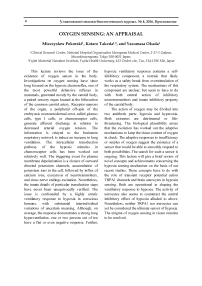Oxygen sensing: an appraisal
Автор: Pokorski Mieczyslaw, Takeda Kotaro, Okada Yasumasa
Журнал: Ульяновский медико-биологический журнал @medbio-ulsu
Статья в выпуске: 4 S, 2016 года.
Бесплатный доступ
This lecture reviews the issue of the existence of oxygen sensor in the body. Investigations on oxygen sensing have since long focused on the hypoxic chemoreflex, one of the most powerful defensive reflexes in mammals, generated mostly by the carotid body, a paired sensory organ located at the bifurcation of the common carotid artery. Receptor neurons of the organ, a peripheral off-spin of the embryonic neuroectodermal crest, called glomus cells, type I cells, or chemoreceptor cells, generate afferent discharge in relation to decreased arterial oxygen tension. The information is relayed to the brainstem respiratory network to induce an increase in lung ventilation. The intracellular transduction pathway of the hypoxic stimulus in chemoreceptor cells has been worked out relatively well. The triggering event for plasma membrane depolarization is a closure of outward directed potassium channels, accumulation of potassium ions in the cell, followed by influx of calcium ions, exocytosis of neurotransmitters, and sinus nerve endings excitation. Nonetheless, the innate details of particular transduction steps have never been unequivocally verified. The issue is confounded by a highly erratic ventilatory response to hypoxia in conscious humans, with substantial interindividual variations of uncertain meaning. Although, on average, the response demonstrates a strong lung hyperventilation, one or two persons out of ten have a flat or even negative response. Further, hypoxic ventilatory response contains a self-inhibitory component, a restrain that likely works as a safety break from overstimulation of the respiratory system. The mechanisms of this component are unclear, but seem to have to do with both central action of inhibitory neurotransmitters and innate inhibitory property of the carotid body. The action of oxygen may be divided into two antithetic parts: hypoxia and hyperoxia. Both extremes are detrimental or life-threatening. The biological plausibility arises that the evolution has worked out the adaptive mechanisms to keep the tissue content of oxygen in check. The adaptive responses to insufficiency or surplus of oxygen suggest the existence of a sensor that would be able to smoothly respond to both possibilities. The search for such a sensor is ongoing. This lecture will give a brief review of novel concepts and achievements concerning the hypoxia sensing mechanism on the basis of our recent studies. These concepts have to do with the role of transient receptor potential cation TRPA1 channels and brain astrocytes in hypoxia sensing. Both are operational in shaping the ventilatory response to hypoxia. The activity of astrocytes also seems to counteract the central inhibitory effect of hypoxia alluded to above. Nonetheless, neither TRPA1 nor astrocytes can yet be considered the ultimate sensor of hypoxia. The enigma of oxygen sensing in tissue remains to be resolved.
Короткий адрес: https://sciup.org/14113212
IDR: 14113212


